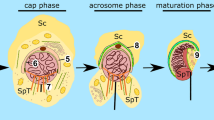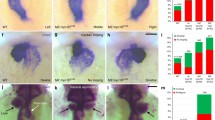Abstract
Myosin VI (MyoVI) is a pointed-end-directed, actin-based motor protein1,2, and mutations in the gene result in disorganization of hair cell stereocilia and cause deafness in mice3. MyoVI also localizes to the leading edges of growth-factor-stimulated fibroblast cells4 and has been suggested to be involved in cell motility5. There has been no direct test of this hypothesis, however. Drosophila melanogaster MyoVI is expressed in a small group of migratory follicle cells, known as border cells. Here we show that depletion of MyoVI specifically from border cells severely inhibited their migration. Similar to MyoVI, E-cadherin is required for border cell migration. We found that E-cadherin and Armadillo (Arm, Drosophila β-catenin) protein levels were specifically reduced in cells lacking MyoVI, whereas other proteins were not. In addition, MyoVI protein levels were reduced in cells lacking DE-cadherin or Arm. MyoVI and Arm co-immunoprecipitated from ovarian protein extracts. These data suggest that MyoVI is required for border cell migration where it stabilizes E-cadherin and Arm. Mutations in MyoVIIA, another unconventional myosin protein, also lead to deafness, and MyoVIIA interacts with E-cadherin through a membrane protein called vezatin6. Multiple biochemical mechanisms may exist, therefore, for cadherins to associate with diverse unconventional myosins that are required for normal stereocilium formation or maintenance.




Similar content being viewed by others
References
Rodriguez, O. C. & Cheney, R. E. Trends Cell Biol. 10, 307–311 (2000).
Titus, M. A. Curr. Biol. 10, R294–R297 (2000).
Friedman, T. B., Sellers, J. R. & Avraham, K. B. Am. J. Med. Genet. 89, 147–157 (1999).
Buss, F. et al. J. Cell Biol. 143, 1535–45. (1998).
Deng, W., Leaper, K. & Bownes, M. J. Cell Sci. 112, 3677–3690 (1999).
Kussel-Andermann, P. et al. EMBO J. 19, 6020–6029 (2000).
Wells, A. L. et al. Nature 401, 505–508 (1999).
Buss, F., Arden, S. D., Lindsay, M., Luzio, J. P. & Kendrick-Jones, J. EMBO J. 20, 3676–3684 (2001).
Mermall, V. & Miller, K. G. J. Cell Biol. 129, 1575–1588 (1995).
Hicks, J. L., Deng, W. M., Rogat, A. D., Miller, K. G. & Bownes, M. Mol. Biol. Cell 10, 4341–4353 (1999).
Montell, D. J. Mech. Dev. 105, 19–25 (2001).
Spradling, A. C. in Developmental Genetics of Oogenesis (eds. Bate, M. & Martinez-Arias, A.) 1–70 (Cold Spring Harbor Laboratory Press, Cold Spring Harbor, 1993).
Ruohola, H. et al. Cell 66, 433–449 (1991).
Niewiadomska, P., Godt, D. & Tepass, U. J. Cell Biol. 144, 533–547 (1999).
Silver, D. L. & Montell, D. J. Cell 107, 831–841 (2001).
Montell, D. J., Rørth, P. & Spradling, A. C. Cell 71, 51–62 (1992).
McCrea, P. D., Turck, C. W. & Gumbiner, B. Science 254, 1359–1361. (1991).
Oda, H., Uemura, T., Harada, Y., Iwai, Y. & Takeichi, M. Dev. Biol. 165, 716–726. (1994).
Bai, J., Uehara, Y. & Montell, D. J. Cell 103, 1047–1058 (2000).
Peifer, M. J. Cell Sci. 105, 993–1000 (1993).
Murphy, A. M. & Montell, D. J. J. Cell Biol. 133, 617–630 (1996).
Rørth, P. et al. Development 125, 1049–1057 (1998).
Luo, L., Liao, Y. J., Jan, L. Y. & Jan, Y. N. Genes Dev. 8, 1787–1802 (1994).
Palmer, R. H. et al. J. Biol. Chem. 274, 35621–35629 (1999).
Acknowledgements
We would like to acknowledge M. Bownes and K. Miller for MyoVI reagents and useful discussions. We thank M. Peifer for the Armadillo constructs. We thank C. Montell and members of the laboratory for critical reading of the manuscript. This work was supported by a grant from the National Institutes of Health, GM46425.
Author information
Authors and Affiliations
Corresponding author
Ethics declarations
Competing interests
The authors declare no competing financial interests.
Rights and permissions
About this article
Cite this article
Geisbrecht, E., Montell, D. Myosin VI is required for E-cadherin-mediated border cell migration. Nat Cell Biol 4, 616–620 (2002). https://doi.org/10.1038/ncb830
Received:
Revised:
Accepted:
Published:
Issue Date:
DOI: https://doi.org/10.1038/ncb830
- Springer Nature Limited
This article is cited by
-
Spatiotemporal expression of regulatory kinases directs the transition from mitosis to cellular morphogenesis in Drosophila
Nature Communications (2022)
-
Differentiation of follicular epithelium in polytrophic ovaries of Pieris napi (Lepidoptera: Pieridae)—how far to Drosophila model
Protoplasma (2019)
-
miR-143 and miR-145 inhibit gastric cancer cell migration and metastasis by suppressing MYO6
Cell Death & Disease (2017)
-
Diverse functions of myosin VI elucidated by an isoform-specific α-helix domain
Nature Structural & Molecular Biology (2016)
-
Myo10 is required for neurogenic cell adhesion and migration
In Vitro Cellular & Developmental Biology - Animal (2015)





